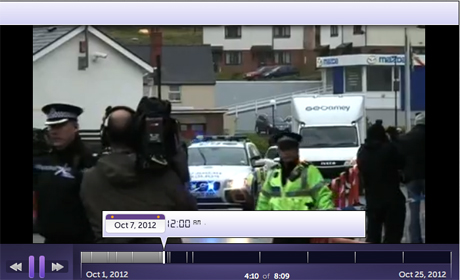
WalesOnline Meograph on the April Jones case
Multimedia storytelling tool Meograph has announced a number of new updates to the platform, including making the geographical pinpointing of a 'moment' within a story optional.
The tool, which enables journalists to plot the times and places of a story on a map and timeline, was launched in July this year. Users can also add multimedia content to each 'moment', such as images, YouTube videos and links to outside articles, as well as audio narration.
The end result is an embeddable Meograph, a playable multimedia package that documents a story. Here is an example of how Meograph has been used by WalesOnline to timeline the April Jones case (pictured above).
The latest updates mean journalists can now use the platform to cover a wider range of stories, founder Misha Leybovich told Journalism.co.uk
"The geography previously was sort of the biggest part of the tool and a lot of times it was really helpful to be able to put stuff in context, but a lot of feedback we got from journalists was that they liked the ability to easily create these video stories and they liked the geography sometimes but not necessarily all the time," he said.
"Not every moment of every story necessarily has a geography that's important. So we made a very simple change, we said if you put geography for any given moment of any story then it will appear like it does now, you'll have the map in the background and you'll have the media associated with that taking up about two-thirds of the screen.
"However, if you have any moment where you think the geography is not important, or maybe you've established the geography and then you don't want to show it any more, then all you do is not put in a 'where' and the media expands and fills the entire player screen."

He added that "from the user's perspective, the authoring interface looks exactly the same."
"It dramatically expands the range of stories you can tell because before you'd really only use it if there was a story that had a lot of geography. Now you can do it for a story that has no geography at all, or some if you like."
He said so far statistics are showing that when a Meograph is embedded in a page, one third of readers are watching it, which he said is "actually a huge number".
"We thought it was going to be one tenth, because any time you have media there to get people to actually click on it and use it, it can be tough because people are busy.
"But we're finding it looks compelling enough and it's interesting enough to folks, to where one out of three is actually watching it all the way through and they're spending three minutes longer on average engaging with that page when they watch a Meograph there.
"Because not only are they watching the Meograph but a lot of times they're actually clicking through and clicking on the different embedded links and just interacting with it."
Other updates to the platform include the ability to both author and playback Meographs in all browsers, previously authoring only worked in Chrome.
Meograph has also launched a page dedicated to the use of the tool by journalists and news outlets. Currently the page outlines the benefits for news sites and links to "very journalist-specific" demos. In time it will also collect "more examples of Meograph used live in the field, different how-tos, anything related specifically to journalists".
Leybovich added that "journalism is right now by far the main driver of our page views".
"We've now started to have news organisations actually start to pick up Meograph organically, people who I haven't even talked to or reached out to".
Revenue potential for news outlets
In the new year Meograph plans to introduce ways to help news outlets make money through advertising when using Meograph.
"One of the big reasons that news organisations want to scale the creation of video is the CPMs [cost per thousand] for video ads are far and away much, much higher than for display ads.
"... The problem for news organisations is the ability to scale the creation of video. So what we do is we allow you to create a lot of video very quickly and then be able to serve ads on top of it.
"Right now we haven't yet offered the ability to serve ads on top of it because we've been focused on making the product as good as possible, but early in the new year we're going to start offering that back-end and either have us work with a video-ad network and do a revenue share on this new revenue with the news organisation, or offer a licence where the news organisation can actually pay for the use of Meograph and then serve their own ads for which they'll get even higher CPMs if they have direct sales."
Free daily newsletter
If you like our news and feature articles, you can sign up to receive our free daily (Mon-Fri) email newsletter (mobile friendly).









